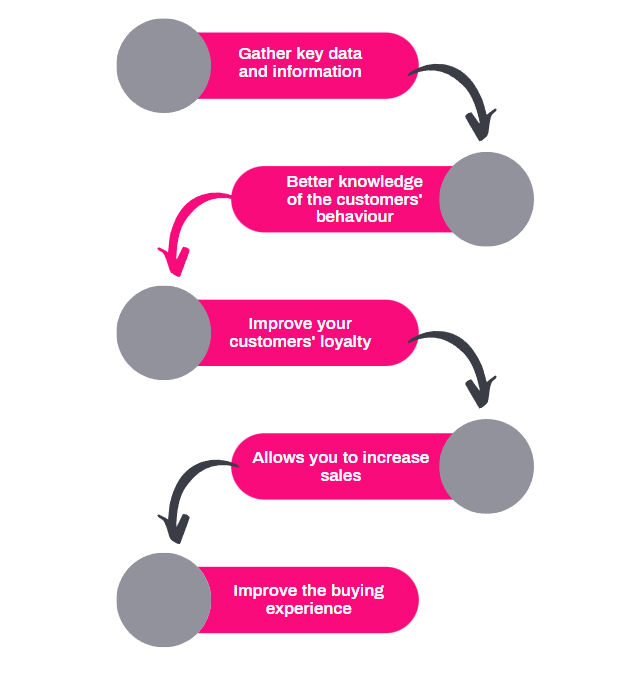Retail
Omnichannel retail: the strategy of the future
2023
To survive in a highly digitalised world, it’s fundamental for retailers to include a new word concept in their vocabulary: omnichannel retail.
The key meaning of the concept of omnichannel retail is to offer clients a continuity between the online and offline world, thus managing to satisfy their needs on every possible buying channel.
But why is it so important to develop an efficient omnichannel strategy? Let’s discover that in this article.

Over the years, the retail sector has drastically changed. If a few years ago the customer journey was linear, today it is more irregular than ever. An example? Nowadays a client sees a pair of shoes online, chooses to go try them in-store, and then buys them through an app.
It’s right here that the importance of an omnichannel strategy plays its key role: satisfy the needs of your clients in every phase of the buying process.
The digitalisation, in this case, becomes a great development opportunity both for the store and the retailers, as it permits them to meet the client’s needs and allows them to purchase in the way that they best prefer. By doing so, the new client will leave satisfied with his experience and the loyal will have yet another reason to return.
So, an omnichannel strategy has the client as its only protagonist. The customer journey is fluid, without obstacles, and all the channels are synergically connected to make the buying experience the best it can be.
Furthermore, there’s another aspect that makes an omnichannel strategy the winning choice. The equation is very simple: more distribution channels, more possibilities of being discovered, more clients.
So, how do you put all of this into practice and create a profitable omnichannel strategy?

First, you need to understand that an omnichannel strategy is first and foremost a marketing strategy. For this reason, the foundations of an omnichannel strategy usually are marketing and sales departments that know how to effectively communicate with each other and are always on top of all the market trends.
As we already mentioned, one of the most important characteristics of an omnichannel strategy is to create an easy and linear buying experience. But what exactly does this mean? It means implementing an inclusive approach that includes all the different distribution channels and, most importantly, does not consider each one of them as a different entity.
Here are some of the best practices to follow for a winning omnichannel strategy:
The last thing to keep in mind, but certainly not the least important, is the analysis of your customers' behaviour. How can you measure it and draw the basis of your strategy?
In your strategy, the client is the number one player and so it is vital to analyse its behaviour and its experience with your brand and your services.
How do your clients behave? What do they need? What attracts them the most about your brand? How do they interact with your store?
These are the first questions that you should ask yourself when you’ll decide to implement an omnichannel strategy. Analysing your customer's behaviour is the key that will open the doors of success to your business.
With its people counting and customer behaviour analysis systems, TC Group Solutions will help you gather all the questions to these, and more, answers. Contact us now to receive more information and follow our Linkedin so that you don't miss out on anything!
The key meaning of the concept of omnichannel retail is to offer clients a continuity between the online and offline world, thus managing to satisfy their needs on every possible buying channel.
But why is it so important to develop an efficient omnichannel strategy? Let’s discover that in this article.

An omnichannel strategy and the customer’s buying experience
Over the years, the retail sector has drastically changed. If a few years ago the customer journey was linear, today it is more irregular than ever. An example? Nowadays a client sees a pair of shoes online, chooses to go try them in-store, and then buys them through an app.
It’s right here that the importance of an omnichannel strategy plays its key role: satisfy the needs of your clients in every phase of the buying process.
The digitalisation, in this case, becomes a great development opportunity both for the store and the retailers, as it permits them to meet the client’s needs and allows them to purchase in the way that they best prefer. By doing so, the new client will leave satisfied with his experience and the loyal will have yet another reason to return.
So, an omnichannel strategy has the client as its only protagonist. The customer journey is fluid, without obstacles, and all the channels are synergically connected to make the buying experience the best it can be.
Furthermore, there’s another aspect that makes an omnichannel strategy the winning choice. The equation is very simple: more distribution channels, more possibilities of being discovered, more clients.
So, how do you put all of this into practice and create a profitable omnichannel strategy?

Implementing an omnichannel retail strategy: Where do I start?
First, you need to understand that an omnichannel strategy is first and foremost a marketing strategy. For this reason, the foundations of an omnichannel strategy usually are marketing and sales departments that know how to effectively communicate with each other and are always on top of all the market trends.
As we already mentioned, one of the most important characteristics of an omnichannel strategy is to create an easy and linear buying experience. But what exactly does this mean? It means implementing an inclusive approach that includes all the different distribution channels and, most importantly, does not consider each one of them as a different entity.
Here are some of the best practices to follow for a winning omnichannel strategy:
- Use the same images and messages on all the different channels
- Allow the “click and collect” option
- All the different campaigns must be the same on all channels
- All your products must be available on all the distribution channels
The last thing to keep in mind, but certainly not the least important, is the analysis of your customers' behaviour. How can you measure it and draw the basis of your strategy?
The customer’s behaviour as the starting point of an omnichannel strategy
In your strategy, the client is the number one player and so it is vital to analyse its behaviour and its experience with your brand and your services.
How do your clients behave? What do they need? What attracts them the most about your brand? How do they interact with your store?
These are the first questions that you should ask yourself when you’ll decide to implement an omnichannel strategy. Analysing your customer's behaviour is the key that will open the doors of success to your business.
With its people counting and customer behaviour analysis systems, TC Group Solutions will help you gather all the questions to these, and more, answers. Contact us now to receive more information and follow our Linkedin so that you don't miss out on anything!